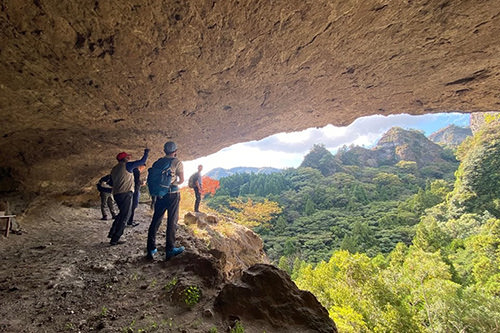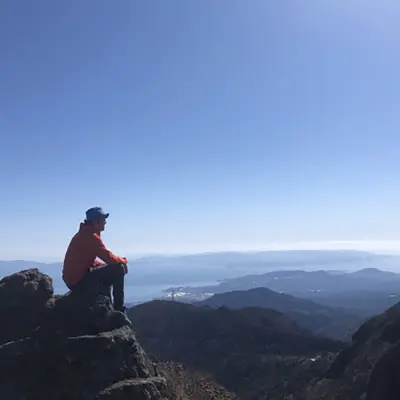
Cycling, Trekking: Experience a lifestyle that hasn’t changed for a thousand years. Kunisaki Peninsula, where history is accumulating.
Kyushu is the closest region in Japan to China and the Korean Peninsula on the Eurasian continent, and it is said that rice, Japan’s staple food, spread from Kyushu throughout Japan. Buddhism was also introduced to Japan from this continent.
The Kunisaki Peninsula was an important relay point for transmitting this culture to Kyoto, Nara (both are old capitals of Japan) and other places using the Seto Inland Sea. It is no exaggeration to say that it has had a great influence. And while Japan’s culture is changing, its nature, culture and landscape have remained unchanged for 1,000 years. In other words, by looking at the Kunisaki Peninsula, you can learn about Japan’s original landscape.
By trekking along the paths walked by asceticism practicing monks in ancient times, you can get a glimpse of the thoughts of the people of the past, and by interacting with the people who live here now, you can sense the desire to pass on this land to future generations. The Kunisaki Peninsula is a place where you can come face-to-face with Japan’s national spiritual culture.
●Area: Kunisaki Peninsula, Oita Pref.
●Main Activity:
Kunisaki Peninsula Ridge Long Trail, a walk along the path taken by ‘Shugendo’ Buddhist monks.
●Difficulty: 3
●4 nights, 5 days
●Accommodation (Example)
Day 1: Nada Beach House or Hotel Baygrand Kunisaki
Day 2: Ryokan FUKINOTOU
Day 3: PENSION NOJIGIKU, Ryokan Yachiyokan
Day 4: Ryokan Ebisuya
●Meal: 4 breakfasts, 4 lunches, 4 dinners
●PAX: Min Group Size 4/Max Group Size 8
●Price: JPY 280,000- (ask us)
・Cycling from Kitsuki, a castle town where you can feel the samurai era, to the beautiful rice terraces of Tashibu no Sho.
・Kunisaki Peninsula Ridge Long Trail, a walk along the path taken by ‘Shugendo’ Buddhist monks.
・Cultural experiences and trekking that touch the traditions of the small Hime-jima island.

Please gather at Nada Midori-so, which is located right in front of the sea on the Nada coast near Oita Airport. We will introduce you to the topography and culture of the Kunisaki Peninsula and this trip. Afterwards, a Welcome Party begins on the deck facing the sandy beach to enjoy your first night. The harmony of the guide’s talk and the sound of the waves will enrich your thoughts about the next day’s trip.

Setting off from your accommodation you will move to Kitsuki Town by private car. Kitsuki is a town centered around a castle, and the town retains the scenery of the samurai era. There are samurai residences on the hills to the north and south, and a merchant town is sandwiched between them. It is said that this type of ‘sandwich-shaped’ castle town is the only one in Japan. Your cycling trip starts from this town. First, you will explore this unique town of Kitsuki. Enjoy tea at ‘Tomaya’, a Japanese tea shop that has been in business for 280 years. In addition to just drinking tea, you will learn about tea etiquette and the history of the tea ceremony.
The real cycling starts here. The Kunisaki Peninsula is mountainous towards the center, so you will ride an e-bike to climb it. First, you will head over the mountain to Tashibu no Sho. It is said that the rice paddies and villages have not changed at all for 1,000 years. The landscape of rice terraces, which make good use of the gentle alluvial fan slopes, gives you a sense of the wisdom of rice cultivation that has been passed down from ancient times. You will have lunch here, chatting over a charcoal grill with the people who lead their lives in Tashibu no Sho.
You will continue your cycling trip, riding through the peaceful countryside towards Maki Ohdo. Here, you will take a special close look at Buddhist statues that can usually only been seen through glass.
The end of the cycling trip is Fukiji Temple. The main hall here is a national treasure of Japan. When you enter the main hall, you will feel like your soul is being purified. This day’s activities include cycling approximately 38km, an elevation difference of 500m, and a total duration of 6 hours.

Mornings at Fukiji Temple begin with ‘zazen’, ritual morning Zen meditation. If you meditate in the main hall with the faint morning sun shining through, you will feel as if you are free from impurities. After breakfast, you will be transferred to the trekking start point by private vehicle.
The starting point is Saihoji no Sato. From here, you will walk along the path used by Shugendo practitioners in the past. Once you cross the pass, you will be greeted with a view of steep rocky peaks. And your goal is Ofudo Iwaya. A naturally formed cave in the rock is called an Iwaya, and people worshipped it as a place where Buddha resided. Ofudo Iwaya is one of the largest. The view from this cave is truly spectacular. You will have your packed lunch here.
You will descend the mountain and stop off at Sentoji Temple, which is located in a small settlement. Here, you can write your wish on pieces of wood called ‘goma’, used in a holy fire ritual, and then set off heading for the ‘former Sentoji Temple’. In the past, there was a large temple here where many ascetic practitioners lived. Now, the approach to the shrine is covered in moss.
After climbing the mountain, you will arrive at Itsutsuji Fudo on the peak. Prayers for spiritual purification by burning the goma are held at the temple which is built on a steep rock. The goma on which you wrote your wish will be burned, and worshippers will pray that your wish will come true. It also removes impurities from the mind and body.
After descending the mountain, you will head to Imi Port by private vehicle. From here, it’s a 20-minute boat trip to Himeshima, an island nestled quietly on the Kunisaki Peninsula. After arriving at Himeshima you will head to your accommodation.
This day’s activity has a distance of 9km and duration of 6 hours.

Himeshima is famous for the ‘Fox Dance’, which has been passed down from ancient times and is performed at festivals held in the summer. It’s a festival like Hallowe’en. You will be asked to make a mask inspired by this dance Color it with your own design. Also, you can make ‘Imokiri’, a local samurai cuisine. ‘Imokiri’ are noodles made by kneading dried sweet potatoes with water, rolling them out thinly, and cutting them into thin pieces. They have a slightly sweet and chewy texture. Perfect for lunch.
After lunch, you will trek up Mt. Yahazu (266m above sea level) on Himeshima. Mt. Yahazu is a volcano that was active about 90,000 years ago, and you will see evidence of the lava that was distributed from the mountainside to the summit. From the top, you can see the Kunisaki Peninsula, over which you have traveled so far.
You will return to Kunisaki Peninsula by ferry, arriving in Beppu by private vehicle, and stay at the accommodation where you can experience the hot spring culture of Beppu Onsen.

The final day starts with an early morning stroll through the steamy hot springs of Myoban Onsen. After breakfast, you will go SUP cruising in Beppu Bay. An adventure aimed at a secret cave that can only be reached from the sea. It will be a great time to look back on your trip, by looking at the Kunisaki Peninsula you visited on the tour, from the sea.
Lunch will be held at Tekizan-so, which conveys the charm of ancient Japanese wooden architecture, and you will enjoy an authentic ‘kaiseki’ meal that is a perfect way to end your trip. A trip that ends with a thousand years of memories of the Kunisaki Peninsula while feeling the vestiges of the past at the ruins of Hiji Castle, in a seaside castle town that retains the atmosphere of the early modern and Edo periods.
Contact
・Toyonokuni Millennium Heritage Tourism Zone
・Tel: +81 977-85-8511
・Email: jikuhaku@millennium-roman.jp
・ https://www.millennium-roman.jp/english/

Book your perfect stay in Kyushu with thousands of properties to choose from
 Trekking,Cycling:UNZEN VOLCANO STORY ~SKY・SEA・EARTH~
Trekking,Cycling:UNZEN VOLCANO STORY ~SKY・SEA・EARTH~ Cycling, Trekking: A story of blessings and threats given by the river - Nakatsu, Yamakuni River
Cycling, Trekking: A story of blessings and threats given by the river - Nakatsu, Yamakuni River Cycling, Trekking: Experience a lifestyle that hasn’t changed for a thousand years. Kunisaki Peninsula, where history is accumulating.
Cycling, Trekking: Experience a lifestyle that hasn’t changed for a thousand years. Kunisaki Peninsula, where history is accumulating. Trekking, Shower Climbing: A journey with Masa to feel the harmony of nature
Trekking, Shower Climbing: A journey with Masa to feel the harmony of nature Trekking, Cycling: A journey into the nature and culture of Hirado, the island where the Samurai first encountered Western culture
Trekking, Cycling: A journey into the nature and culture of Hirado, the island where the Samurai first encountered Western culture Cycling,Trekking:Explore the life around Kyushu's majestic volcano by foot and e-bike
Cycling,Trekking:Explore the life around Kyushu's majestic volcano by foot and e-bike Kayakking,Cycling:A journey to experience the rich climate and lifestyle of the World Natural Heritage Site Amami-Oshima, nurtured by the "Kuro-shio″
Kayakking,Cycling:A journey to experience the rich climate and lifestyle of the World Natural Heritage Site Amami-Oshima, nurtured by the "Kuro-shio″  Trekking:A journey to visit the tracks carved by water and time on the land created by the great pyroclastic flows
Trekking:A journey to visit the tracks carved by water and time on the land created by the great pyroclastic flows 






